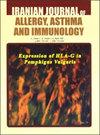MicroRNA-29a-3p通过靶向kr ppel样因子4加速新生儿肺炎的炎症损伤
IF 1.2
4区 医学
Q4 ALLERGY
Iranian journal of allergy, asthma, and immunology
Pub Date : 2023-11-07
DOI:10.18502/ijaai.v22i5.13994
引用次数: 0
摘要
新生儿肺炎(NP)是一种常见于新生儿期的疾病。本研究探讨了microRNA (miR)-29a-3p在NP中的分子过程和作用。采集NP患者和健康新生儿外周血。用脂多糖(LPS)处理人肺成纤维细胞(WI-38),建立NP细胞模型。然后采用RT-qPCR或Western blot检测miR-29a-3p和kr本文章由计算机程序翻译,如有差异,请以英文原文为准。
MicroRNA-29a-3p Accelerates Inflammatory Damage in Neonatal Pneumonia Via Targeting Krüppel-like Factor 4
Neonatal pneumonia (NP) is a frequently occurring illness during the neonatal phase. The study investigated the molecular process and the role of microRNA (miR)-29a-3p in NP.
Peripheral blood was collected from NP patients and healthy newborns. Human lung fibroblasts cell line (WI-38) were treated with lipopolysaccharide (LPS)) to establish a cellular model for NP. Then, miR-29a-3p and Krüppel-like Factor 4 (KLF4) levels were detected by RT-qPCR or Western blot. The relationship between miR-29a-3p and KLF4 was confirmed by dual luciferase reporter gene assay. Cell survival was assessed using the CCK-8 assay, whereas the levels of interleukin-6, tumor necrosis factor-α, and IL-1β were quantified using ELISA. Additionally, apoptosis was evaluated through flow cytometry. Meanwhile, Bax and Bcl-2 were detected by RT-qPCR. Neonatal rats were administered LPS intraperitoneally (3 mg/kg) to induce NP, and pathological injury and inflammatory reaction were analyzed.
MiR-29a-3p was elevated but KLF4 was silenced in NP patient’s serum, LPS-treated WI-38 cell line, and LPS-treated newborn rats. Silence of miR-29a-3p or elevation of KLF4 constrained cell proliferation with inflammation of LPS-treated WI-38 cell line. MiR-29a-3p immediately targeted KLF4. Additionally, silence of miR-29a-3p alleviated LPS-stimulated lung injury and inflammation in neonatal rats. The protective action of silenced miR-29a-3p in LPS-treated WI-38 cell line and newborn rats was turned around by silencing KLF4.
This study demonstrates originally that miR-29a-3p boosts inflammatory damage in NP via targeting KLF4, offering a basis for clinically diagnosing and treating NP.
求助全文
通过发布文献求助,成功后即可免费获取论文全文。
去求助
来源期刊
CiteScore
2.60
自引率
6.70%
发文量
64
审稿时长
>12 weeks
期刊介绍:
The Iranian Journal of Allergy, Asthma and Immunology (IJAAI), an international peer-reviewed scientific and research journal, seeks to publish original papers, selected review articles, case-based reviews, and other articles of special interest related to the fields of asthma, allergy and immunology. The journal is an official publication of the Iranian Society of Asthma and Allergy (ISAA), which is supported by the Immunology, Asthma and Allergy Research Institute (IAARI) and published by Tehran University of Medical Sciences (TUMS). The journal seeks to provide its readers with the highest quality materials published through a process of careful peer reviews and editorial comments. All papers are published in English.

 求助内容:
求助内容: 应助结果提醒方式:
应助结果提醒方式:


